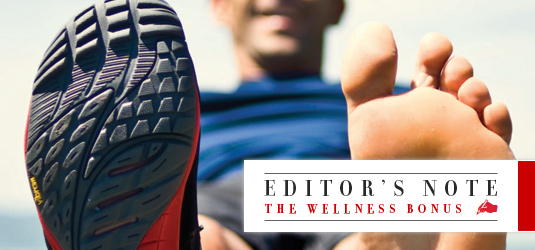There are obvious benefits associated with wearing wellness footwear—those styles that, for discussion’s sake, fall under the toning/shaping and barefoot categories. These include the strengthening of various foot and leg muscles, improved posture, pain relief, an incentive to become more active (and burn more calories) and the peace of mind that comes from knowing you’re doing your body good. Yes, in a time-starved, multitasking world where versatile products that deliver tangible benefits are a prerequisite to purchasing, wellness footwear surely delivers. On top of that, there’s potential cost savings for shoppers who are looking to get a workout in amid their daily routines instead of shelling out for pricey gym memberships. And there’s the fashion bonus: Many consumers enjoy being part of the popular tribe.
But in addition to the attributes wellness footwear offers consumers, there’s a bottom-line bonus for our industry. Many of these shoes (by the likes of MBT, Skechers, Alegria and Vibram FiveFingers, to name a few) are selling like hotcakes. Even better, they generally go for $70 to $200-plus. Unlike the Crocs phenomenon, these offer margins retailers can sink their teeth into. And in a brutal recession, any shoes that are selling provide welcome relief.
The burgeoning wellness movement is also allowing both comfort and athletic dealers a new opportunity to cash in on an area in which product knowledge and hands-on fitting are key—and “lowest price” isn’t the leading factor. Wellness has the makings of a standalone category spanning an assortment of products addressing a wide range of needs. Look for an evolution of exciting, innovative store formats catering to educated, affluent consumers who view these products as a worthy investment. In short, the wellness movement goes way beyond shoppers seeking firmer glutes. But, hey, that’s a great place to start if you want to create noise in a body image–obsessed world.
Thanks to the wellness buzz, shoes are once again a hot topic. The fact that millions of people are discussing how footwear can enhance their overall wellbeing has tremendous trickle-up benefits. And there’s another, perhaps surprising, bonus related to wellness footwear: I expect it will actually encourage women to wear their so-called “unhealthier” high heels on occasion. Not unlike conscientious dieters who indulge in a brownie every now and then as a reward, wellness shoes may help women justify a night out in killer stilettos. Wellness footwear is not an either/or proposition. Sure, there will be disciples who wear little else, but I predict millions more will add wellness shoes to their wardrobes just as they have added Uggs, which have inarguably transcended the fad stage to become a comfort staple.
To the wellness category, I say, welcome to our footwear family. There’s always room for one more. —Greg Dutter




